Xml Can Attributes From One File Pass Into Another File
Adobe InDesign CS5 is ane of many applications that can produce and use XML. Afterwards you tag content in an InDesign file, you salve and export the file as XML so that it can be repurposed in another InDesign file or another application. Similarly, you tin can import an XML file into InDesign and instruct InDesign to display and format the XML data any fashion you want.
About XML
XML (Extensible Markup Language) is a way to repurpose information in a file or automate the procedure of replacing the data in one file with data from another file. XML employs tags to describe parts of a file—a heading or a story, for example. These tags marker data so it tin exist stored in an XML file and handled appropriately when it is exported to other files. Think of XML as a translation mechanism for data. XML tags characterization text and other content in a file so that applications tin recognize and present the data.
XML is considered an extensible language because individuals create their ain XML tags—they can create one tag for each type of information that they want to repurpose. XML tags don't conduct information about how data is supposed to exist displayed or formatted. XML tags are strictly for identifying content.
In InDesign, for example, you tin can create a Heading1 tag and assign information technology to each first-level heading in a document. After you relieve the document as an XML file, the Heading1 content tin can be imported and put to use—by any application that tin can read XML—equally a web page, printed catalog, directory, price list, or database table.
InDesign is one of many applications that can produce and employ XML. Later on you tag content in an InDesign file, yous salve and consign the file as XML and so that it can be repurposed in some other InDesign file or some other awarding. Similarly, you tin import an XML file into InDesign and instruct InDesign to brandish and format the XML data any mode you lot want.
Adobe InCopy is one of many applications that tin can produce and employ XML. After you lot tag content in an InCopy file, you lot relieve and export the file every bit XML and then that information technology can be repurposed in another InCopy file, InDesign file, or some other application.
In InDesign, y'all can create XML tags and tag parts of a document even if yous're non experienced with XML. InDesign handles XML programming behind the scenes and creates the XML for you when you export a document in XML format.
Exercise non confuse XML tags with InDesign tagged text. For more than data virtually tagged text, which is a different method of exporting and importing InDesign content, view the Tagged Text PDF at www.adobe.com/go/learn_id_taggedtext_cs5_en (PDF).
The chemical element is the building block of XML data; an element is data that has been tagged. In XML files, elements are nested within other elements to create a hierarchical structure for the data.
You lot tin see the structure of XML information in the Construction pane, which displays the hierarchy and sequence of elements. In the XML structure, child elements are contained by parent elements, which in plough may also be child elements. Or, seen from the other management, parent elements contain child elements, and these kid elements may in turn be parent elements to other child elements.
For instance, in the following paradigm, you can see a chapter element that contains (is the parent of) several recipe elements. Each recipe chemical element, in turn, is the parent of elements called recipename, ingredients, instructions, notes, and servings. All elements are contained inside the Root element, which appears at the top of the Structure pane.
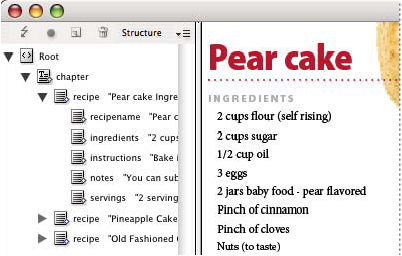
For instance, in the following image, yous tin see a chapter element that contains (is the parent of) a recipe element. The recipe element, in plough, is the parent of elements called recipename and ingredients. All elements are contained within the Story element, which always appears at the summit of the Structure pane.
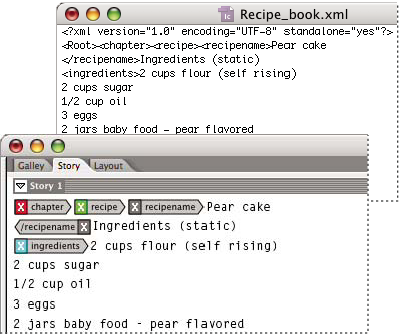
For more data on using XML in InDesign, visit www.adobe.com/go/learn_id_XMLscript.
InDesign provides the Construction pane and the Tags console for working with XML content. The Structure pane displays all the elements in the certificate and their hierarchical structure. To help you lot identify each chemical element, InDesign displays its element tag and an icon that indicates what type of content it holds. In addition, the Construction pane tin display the commencement few words of text in an chemical element, called a text snippet, which is not to exist dislocated with snippet files that store objects for reuse.
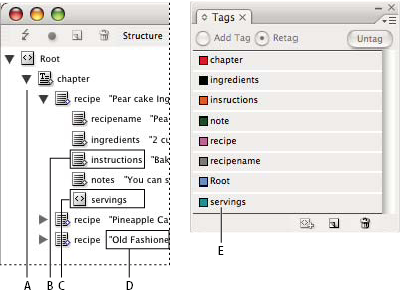
A. Triangle to aggrandize or plummet elementsB. Chemical element (placed in layout)C. Element (non in layout)D. Text snippetEastward. Element tag
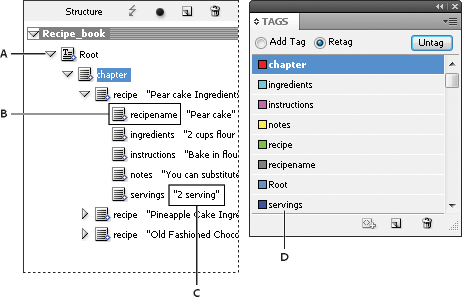
A. Triangle to expand or collapse elementsB. Element placed in layoutC. Text snippetD. Element tag
The Structure pane lets you view, edit, and manage XML elements. You use the Construction pane in many means when working with XML. For example, to place imported XML content into the layout, y'all can elevate elements from the Structure pane directly to a page. Y'all also use the Structure pane to adapt the hierarchy of the elements. You tin add elements, attributes, comments, and processing instructions past way of the Construction pane.
The Tags panel lists tags for elements. You can import, export, add together, delete, and rename tags. Yous use the Tags panel to employ element tags to content that you program to export to XML, and to utilize tags to frames before importing XML content into them.
The Tags panel lists tags for elements. You lot tin import, export, add, delete, and rename tags. Y'all use the Tags panel to employ element tags to content that yous plan to consign to XML.
About DTD files
To share XML data with others, y'all need to concur on a standard set of tag names and element attributes so that anybody in your group uses and applies tags the aforementioned way. One method for handling the sharing of XML information is to use a document type definition (DTD) file.
A DTD file provides a fix of elements and attributes for members of the group to utilize. It also defines the rules nearly where elements can appear in the structural hierarchy. For example, the DTD file may require the Title element to be a child of the Story chemical element because the title is supposed to appear inside the story; if you tag a title without tagging the story information technology appears in, the DTD file marks the Championship chemical element as invalid. You can search for and flag invalid structural errors in an InDesign file with a DTD file. This procedure is chosen validating .
To apply a DTD file (if your document doesn't already contain one), you load information technology into your document. This imports the element names from the DTD into the Tags panel. Others who have loaded the same DTD file have the aforementioned element names, which ensures that everyone in the group uses the same elements. The imported elements are locked, which means they can't be deleted or renamed unless the DTD file is deleted from the document.
Although yous cannot import a DTD file into InCopy, DTD files you import in InDesign are available when y'all edit the story in InCopy. Yous tin view the DTD file in InCopy and validate stories against it to ensure that tags take been applied correctly.
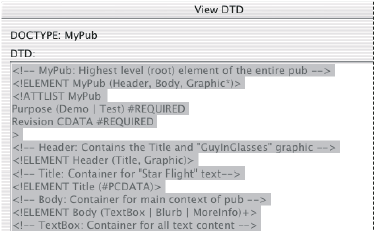
You lot may observe that a DTD file created past a group or industry similar to yours includes tags and structures that run into your needs. For a current listing of registered DTDs, visit www.xml.com/pub/rg/DTD_Repositories (English language only).
XML rule sets
XML rule sets are sets of instructions written in a scripting language (such every bit JavaScript or AppleScript) that evaluate XML information and take sure actions if that data meets certain conditions. Each rule consists of at least 1 condition and at to the lowest degree one action. A rule evaluates the XML data against the atmospheric condition, and if a condition is met, and so it takes the advisable action. For example, an XML rule tin specify that whenever the Paragraph element appears under the Subhead chemical element (a status), a specific manner (an action) is applied; or that whenever the Production element (a condition) appears, a new frame is created and a product image is imported (actions). XML rules are a means of dynamically creating and formatting layouts based on XML.
For data on XML rule sets and other XML scripting resources, come across www.adobe.com/go/learn_id_XMLscript.
Preparing XML files for K4 or InCopy workflows
To prepare files with XML tagging for apply within the K4 or InDesign/InCopy workflow environments, yous may need to accommodate how yous ready the construction and import XML into InDesign files.
At that place are two methods for importing XML into InDesign: merge and append. Merge tin supervene upon the existing structure, whereas append adds to whatever existing structure. In both cases, it is important that the root element is not associated with a text frame. Either use the default chemical element named "Root" or rename this element based on your current workflow or requirement as needed, again being certain that it is not associated with a text frame.
For more information on using XML in K4 or InCopy workflows, contact your system administrator.
0 Response to "Xml Can Attributes From One File Pass Into Another File"
Post a Comment